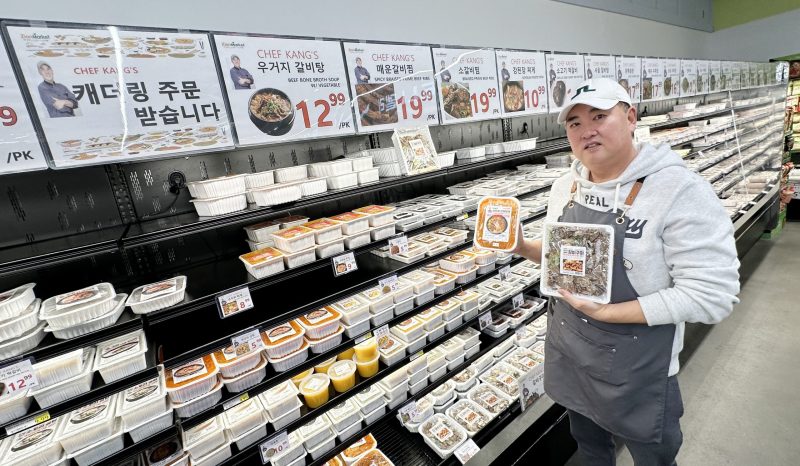After a soft opening in September and its official launch in December, Zion Market’s new Oxford location in Los Angeles Koreatown is quickly becoming a popular grocery spot. Within just a few months of moving from its previous Vermont location, the store’s most trafficked section is none other than its side dish (banchan) section.
Located on the first floor of the Rise Koreatown mixed-use apartment complex at 8th Street and Oxford Avenue, the market was optimized for its prime location. Unlike traditional Korean American supermarkets, Zion Market introduced a “Superette” style, combining the best elements of a traditional large supermarket and a modern convenience store. The core of its marketing strategy revolves around three key factors: small portions, meal kits, and affordability.
The banchan section embodies this strategy. Since the soft opening, meal kit sales have more than tripled in just four months. During an economic slowdown, the key to increasing revenue has been the introduction of chef-prepared dishes, meal kits, and small-packaged banchan.

This new approach is the result of a collaboration between Zion Market’s store manager, John Yoon, and Chef John Kang, who is spearheading the banchan department’s transformation.
Kang, who operates the Korean restaurants Haneum and Dasom, co-founded P&J International Korean Food with Philip Kim to revolutionize the market’s banchan offerings. “The reason for the explosive growth in meal kit sales is simple—value for money,” Kang explained. “We sell meal kits at half the price of restaurant takeout, reducing the financial burden on customers.”
Most of the banchan department’s menu is based on Kang’s restaurant recipes. The market currently offers 80 to 100 varieties of banchan, with kimchi products—green onion kimchi, fresh napa cabbage kimchi (geotjeori), and young radish kimchi (yeolmu kimchi)—being particularly well-received.
The recently introduced hot food selection is also gaining popularity. Items such as fried chicken, kimchi fried rice, grilled fish, squid tempura, and beef short ribs offer a variety of options for customers.
The fried chicken is one of the customers’ most popular choices, priced at $14 for a whole chicken (14–16 pieces). Customers have praised it as comparable to popular fried chicken chains, leading to a daily sales volume of over 30 whole chickens.
The market’s kimbap selection has also been upgraded, moving beyond the standard grocery store versions. With six varieties, including pork bulgogi and kimchi fried rice kimbap, the rolls are priced between $5.99 and $6.99 and include crunchy radish strips for added texture.
As word spreads about the convenient meal kits and small-portion banchan, young single households and seniors now make up over 70% of the customer base.
According to Kang, “Our soups and stews are portioned for two people, and a family of four can purchase two to three side dishes for just $10 and enjoy a full meal.” He added, “Many working moms, non-Korean customers looking for Korean food, and especially those preparing meals for their elderly parents buy 10 to 20 packs at a time.”
Koreatown senior centers have started placing catering orders as well. Kang explained, “After seeing the meals provided at senior centers, I was inspired to design more nutritious menus tailored to older adults. We’ve now begun catering for four senior centers and are focusing on developing well-balanced, healthy meal options.”
Beyond banchan, senior center catering, and prepared meals, P&J International Korean Food is setting its sights on distributing authentic Korean meal kits to mainstream American markets.
Kang emphasized, “Rather than modifying Korean food to suit American tastes, we want to introduce authentic, traditional Korean cuisine that has been passed down for thousands of years. My ultimate goal is to bring genuine Korean meal kits to major retailers like Ralphs and Trader Joe’s.”
BY EUNYOUNG LEE [lee.eunyoung6@koreadaily.com]




